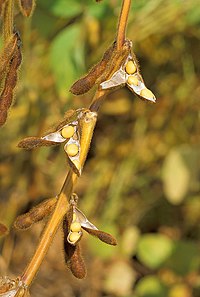
Photo from wikipedia
Soybean fermentation had been done over the years in order to increase its nutritional value. In order to that, our present study was focused on the fermentation of soybean hull… Click to show full abstract
Soybean fermentation had been done over the years in order to increase its nutritional value. In order to that, our present study was focused on the fermentation of soybean hull (SH) by Monascus pilosus KCCM 60084 to enhance the secondary metabolite monacolin K and produce isoflavones such as daidzein and genistein (phytoestrogens). These isoflavones have effect on reducing cholesterol level, anticancer, and anti-osteophorosis. Furthermore, the anti-adipogenesis effect of fermented soybean hull (FSH) and nonfermented soybean hull (NFSH) was investigated by evaluating the molecular signaling at in vitro level (on 3T3-L1 preadipocyte) as well as by the in silico study. Results found that FSH had effect on the reduction of lipid accumulation without exerting any cytotoxicity compared with NFSH at cellular level at 100 µg/mL. In addition, we noticed that it significantly downregulated the mRNA levels of adipogenic transcriptional genes including jak2, STAT3, CEBPα, PPARγ, CEBPβ, and aP2 at same concentration as well as suppressed the protein expression p-STAT3, PPARγ, CEBPα, and aP2. Also, molecular docking studies show that monacolin K, daidzein, and genistein interact with PPARγ reducing lipid accumulation highly than NFSH. We hypothesized that the newly produced isoflavones such as daidzein and genistein and the high amount of secondary metabolite monacolin K conjointly work on reducing lipid accumulation in adipocyte mature cells. Practical applications Soybean product had been used as a food along to functional food for its nutritional value. During the processing of this product the soybean hull (SH) is removed and discarded, since the used is high being a constant problem for soybean processing industries. In this study, we found a possible use for this SH which include its fermentation by Monascus pilosus KCCM 60084. This process gives as a result the transformation of SH metabolite and Isoflavones content increasing the possible uses of SH as a functional food or supplement since exhibits lower toxicity than nonfermented SH. In addition, SH in vitro effect was enhanced after fermentation suggesting a possible a possible preventive or therapeutic use for obesity. The results in this study, not only give us a new process option for soybean hull, but also shown that this fermentation increase its anti-lipogenic effect.
Journal Title: Journal of Food Biochemistry
Year Published: 2018
Link to full text (if available)
Share on Social Media: Sign Up to like & get
recommendations!